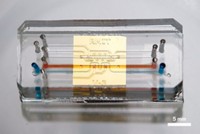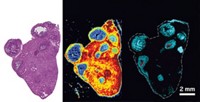Advertisement
Grab your lab coat. Let's get started
Welcome!
Welcome!
Create an account below to get 6 C&EN articles per month, receive newsletters and more - all free.
It seems this is your first time logging in online. Please enter the following information to continue.
As an ACS member you automatically get access to this site. All we need is few more details to create your reading experience.
Not you? Sign in with a different account.
Not you? Sign in with a different account.
ERROR 1
ERROR 1
ERROR 2
ERROR 2
ERROR 2
ERROR 2
ERROR 2
Password and Confirm password must match.
If you have an ACS member number, please enter it here so we can link this account to your membership. (optional)
ERROR 2
ACS values your privacy. By submitting your information, you are gaining access to C&EN and subscribing to our weekly newsletter. We use the information you provide to make your reading experience better, and we will never sell your data to third party members.
Analytical Chemistry
A Giant Leap For Cell Analysis
Mass cytometry boosts the number of single-cell parameters that can be measured simultaneously
by Celia Henry Arnaud
May 16, 2011
| A version of this story appeared in
Volume 89, Issue 20
A novel approach is expanding the versatility of flow cytometry, a particle counting and sorting technique that has been a workhorse of biology labs for decades.
In flow cytometry, researchers use fluorescently labeled antibodies to distinguish among different types of cells. But the need for distinct fluorescent labels and overlap between their fluorescence spectra limit the number of parameters that can be measured in a single analysis.
“There are just so many places along the spectrum that we can create dyes that are sufficiently distinct,” says Garry P. Nolan, a Stanford University biologist who uses flow cytometry to study single cells. “We’re effectively stuck at somewhere between 10 and 15 parameters.”
Now a relatively new method greatly expands the number of parameters that can be measured simultaneously. Developed over the past 10 years by Scott D. Tanner, a chemist at the University of Toronto, the technique, mass cytometry, has the potential to measure 50 or even 100 parameters simultaneously (Anal. Chem., DOI: 10.1021/ac901049w).
In mass cytometry, antibodies are labeled with stable metal isotopes that are “not common in the biological sample you’re running,” Tanner says. “That’s why we like the lanthanides and noble metals.”
Multiple copies of an isotope are attached to an antibody that is specific for a species of interest. After the antibody binds to its target, the cells are introduced into a plasma ionizer, where they are vaporized, atomized, and ionized before analysis by time-of-flight mass spectrometry. The tags are identified in the mass spectrum by their unique atomic mass.
Tanner initially had trouble getting researchers interested in the new technique. “The community that reads Analytical Chemistry is generally not the community that is the target for cytometry technology,” he says. When Tanner cornered Nolan at a meeting to tell him about the technology, Nolan was initially skeptical, but he was quickly convinced.
“Once Tanner answered some basic questions, I realized I better pay attention,” Nolan says. “It could be a major revolution in how we do cell analysis.”
The lanthanides alone provide close to 40 tags, each of which can be attached to an antibody with the same chelator, a “grappling hook” that binds metals in the +3 charge state, Nolan says. Having 40 distinct tags is “an incredible leap in capabilities in terms of the number of parameters you can read per cell,” Nolan enthuses.
Tanner and Nolan have collaborated for the past three years to develop applications of mass cytometry. Earlier this month, they reported the use of mass cytometry and the development of a new algorithm to analyze differences in the way immune cells from human bone marrow respond to drugs (Science, DOI: 10.1126/science.1198704).
They used 13 lanthanide-labeled antibodies that bind cell-surface markers to distinguish various types of immune cells. They used 18 additional lanthanide-labeled antibodies that bind surface markers that further subdivide the types of immune cells. They then used an additional panel of lanthanide-labeled antibodies to reveal information about the activation states of signaling molecules inside the cells.
“We saw that certain kinds of responses transgressed the boundaries of cell types in ways we would not have been able to predict,” Nolan says. For example, some immune cell types, such as B cells and myeloid cells, shared some signaling mechanisms.
They used mass cytometry to examine the effects of drugs on different cell types. They observed changes in cell signaling that resulted from treatment with dasatinib, a leukemia drug that inhibits protein phosphorylation. The mass cytometry study showed that the drug restored signaling of a disrupted phosphorylation pathway in all but one immune cell type—a finding that would have been difficult to tease out with any other technique.
Tanner says that he and his coworkers can now probe up to 39 markers simultaneously. That number will grow as they add more chelators and metal isotopes, he says. The biggest roadblock is finding affinity reagents such as antibodies that specifically bind molecules of interest.
“This new technology, while still in its infancy, has tremendous potential to provide high-content information at the level of individual cells,” says Mario Roederer, chief of the ImmunoTechnology Section at the National Institute of Allergy & Infectious Diseases. “By simultaneously interrogating signaling pathways across a wide swath of cell types, this technology will be a keystone to future diagnostic and drug discovery efforts.”






Join the conversation
Contact the reporter
Submit a Letter to the Editor for publication
Engage with us on Twitter